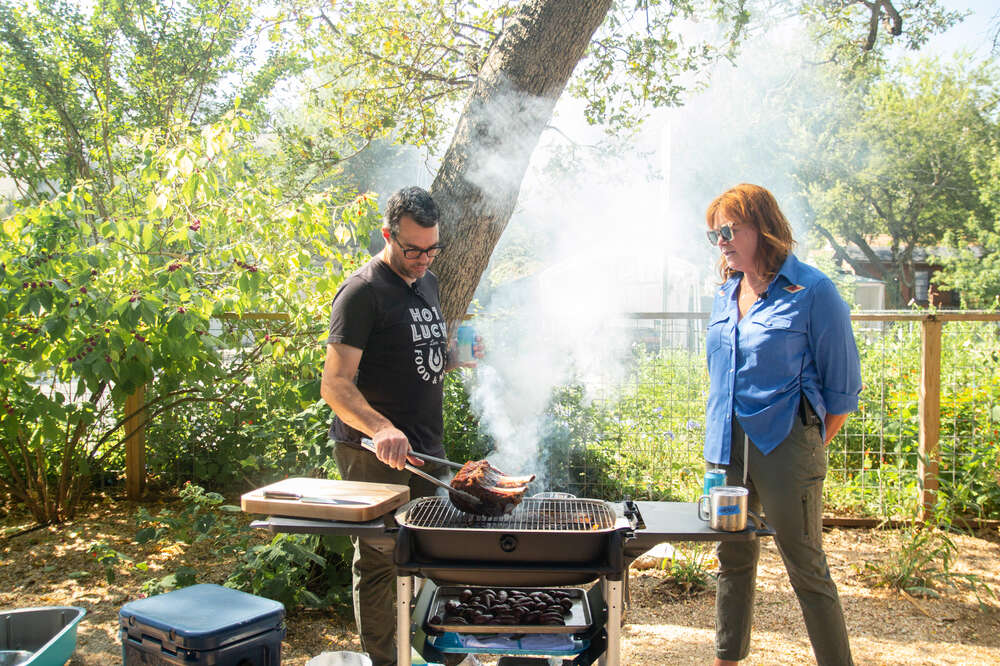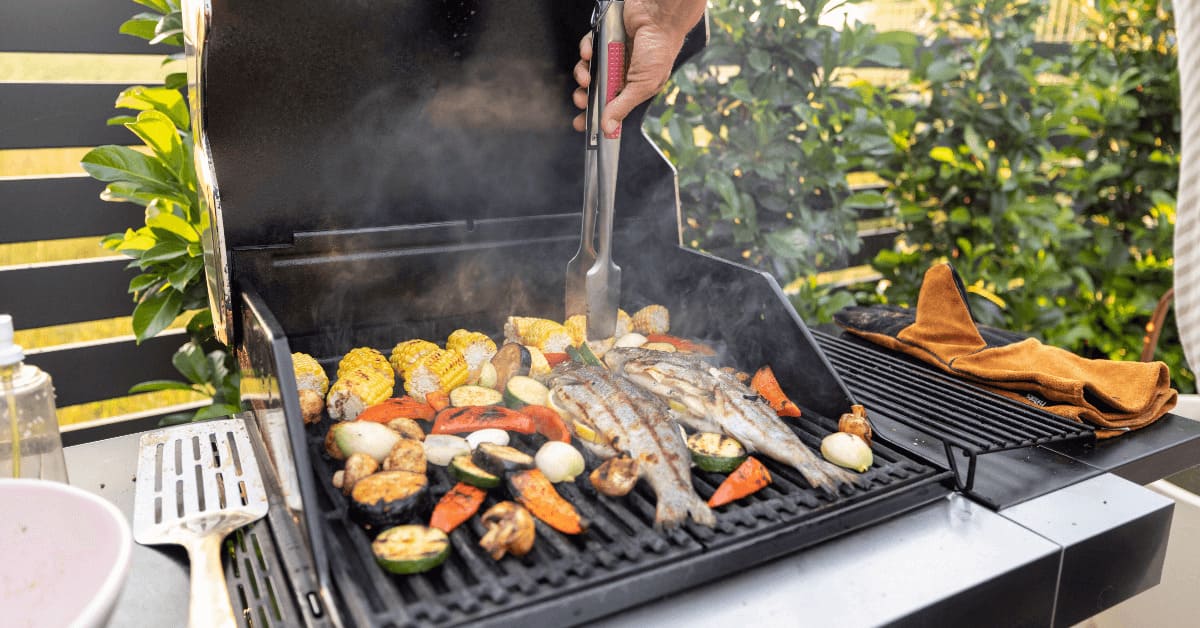How to Cook Turkey on a Gas Grill - Your Ultimate Guide
Written By James Morgan
If you're new to the idea of grilling a turkey or just looking to up your holiday game, learning how to cook turkey on a gas grill could be your ultimate culinary ace in the hole. Grilling a turkey introduces a unique smokey flavor and frees up your oven for other tasty sides. This comprehensive guide caters to barbecue enthusiasts at all levels, guaranteeing you'll nail that perfect turkey every time. With step-by-step instructions, key tips, and essential cookware recommendations, we're here to make sure your grilled turkey becomes the unforgettable centerpiece of your holiday meal.

Why Choose a Gas Grill for Turkey?
A gas grill is a flexible cooking tool that offers the convenience of controlled heat along with the joy of outdoor cooking. When it comes to grilling turkey, the gas grill excels for several reasons. Primarily, gas grills offer a steady source of heat, essential for cooking a large bird like turkey. This minimizes the risk of temperature fluctuations, which could result in an undercooked or overcooked bird.
Moreover, using a gas grill for turkey adds a beautiful smoky flavor that's difficult to replicate in a conventional oven. Imagine a rich, crisp skin with a hint of smoke complementing juicy, tender meat. Delicious, right? Plus, one of the best advantages is freeing up your oven to focus on other holiday essentials like pies and casseroles without any fuss.
Ingredients You'll Need
- 1 whole turkey (12-14 pounds, thawed if frozen)
- 2 tablespoons olive oil
- Salt and pepper to taste
- 1 lemon, quartered
- 1 onion, quartered
- 3-4 cloves of garlic
- Fresh herbs (rosemary, thyme, and sage)
- 1 cup chicken broth
- Optional: Your favorite BBQ rub or marinade
Essential Cookware and Equipment
Before diving into the process, let's gather all the necessary equipment:
- Gas Grill
- Knife
- Cutting Board
- Meat thermometer
- Aluminum foil
- Large roasting pan or drip pan (oven-safe)

Step-by-Step Guide on How to Cook Turkey on a Gas Grill
Let's delve into the actual process to ensure that every step of your turkey grilling journey is covered. Successful barbecue enthusiasts know that preparation is everything, and grilling a turkey is no different.
1. Preparation
The first step in achieving the perfect turkey on a gas grill starts well before the bird hits the grates. Preparation is key. Firstly, ensure your turkey is fully thawed. Generally, thawing a turkey in the refrigerator can take several days, so plan accordingly. As a quick tip, allow 24 hours of refrigerator thawing time for every four pounds of turkey.
Once your turkey is thawed, remove the giblets and rinse the bird thoroughly inside and out. Pat it dry with paper towelsa dry surface will help the skin crisp up while grilling. Place your turkey on a cutting board and trim any excess fat. For those who enjoy brining, this is the time to do it. Brining adds moisture and enhances the flavor significantly. Whether you choose a wet or dry brine, make sure to allow enough time for the turkey to absorb those flavors, ideally overnight.
2. Seasoning and Stuffing
With your bird prepped and patted dry, it's time to add flavor. Rub the outside of the turkey with olive oil, which not only adds flavor but also helps create a golden, crispy skin. Generously season the bird with salt and pepper inside and out. Feel free to get creative with your spices. If you prefer traditional flavors, a blend of fresh herbs like rosemary, thyme, and sage will work wonders. Don't forget to season the cavity of the turkey.
Next, stuff the cavity with quartered onions, lemon, and garlic cloves. These aromatics will infuse the meat with subtle flavors as it grills. Adding a cup of chicken broth to the roasting or drip pan will help keep the meat moist during cooking.
3. Setting Up the Gas Grill
Setting up your gas grill for indirect grilling is crucial when cooking a turkey, as direct heat could lead to an overcooked exterior and an undercooked interior. Begin by preheating your gas grill to 325F. If your grill has multiple burners, light them all initially to get the grill hot faster. Once preheated, turn off one side to create an indirect heat zone. For grills with three burners, keep the side burners on and turn off the center burner.
Place a drip pan beneath the grates on the unlit side to catch any drippings. This helps prevent flare-ups and makes for easy cleanup. You can also add a bit of water to the pan to create some steam, which helps keep the turkey moist. Insert a meat thermometer into the thickest part of the turkey breast, making sure it's not touching the bone. Close the grill lid and let your turkey cook slowly and evenly.
4. Cooking Time
Grilling a turkey is not a quick process, but the results are certainly worth the wait. The cooking time for a turkey on a gas grill is approximately 15 minutes per pound. For a 12-14 pound turkey, this equates to 3-3.5 hours. Keep an eye on the temperature, aiming for an internal temperature of 165F in the breast and 180F in the thigh.
During the cooking process, resist the temptation to frequently open the grill lid as this allows heat to escape. However, it's advisable to check every 30 minutes to monitor progress and baste the bird with its own juices to add moisture. If at any point the skin begins to brown excessively, tent it with aluminum foil to prevent burning.
5. The Smoke Factor
One distinctive element of grilling a turkey is the infusion of smoky flavor. To achieve this, you can add soaked wood chips to a smoker box or a foil pouch directly over the heat source. Hickory, apple, or cherry wood chips impart fantastic flavors to turkey. Just be careful not to overdo it; a little smoke goes a long way.

The Perfect Doneness
Achieving the right doneness is the essence of grilling a turkey. A reliable meat thermometer is indispensable. Once the thermometer reads 165F in the breast and 180F in the thigh, your turkey is ready to come off the grill. Remember, the turkey will continue to cook from residual heat even after you remove it from the grill, so if the reading is slightly under, it's still good.
Resting the Turkey
After removing the turkey from the grill, let it rest. Tent it loosely with aluminum foil and allow it to rest for at least 20-30 minutes. This resting period is crucial, as it allows the juices to redistribute throughout the meat, ensuring every bite is tender and flavorful.
Carving and Serving
Now comes the moment of glory! Place your rested turkey back on the cutting board and prepare to carve. A sharp knife is your best ally at this stage. Begin by removing the legs and thighs, followed by the wings. Finally, carve the breast meat against the grain for the juiciest slices. Arrange all pieces on a serving platter and bask in the admiration of your guests.
To add an extra touch, take the drippings from your drip pan and turn them into gravy. Strain the drippings into a saucepan, add a bit of flour and chicken broth, and whisk over medium heat until you have a smooth, rich gravy.

Post-Cooking Cleanup
After enjoying your Thanksgiving feast, it's time to tackle the less glamorous side of grillingcleanup. Proper maintenance of your gas grill and cutting board is essential for their longevity and performance. Clean the grates while they're still warm with a grill brush to remove any charred bits. For stubborn spots, consider using a specialized Cookware Cleaner. Don't neglect your cutting board; periodically treating it with Cutting board oil will keep it in pristine condition.
As an Amazon Associate, I earn from qualifying purchases.
Final Thoughts
Grilling a turkey on a gas grill may seem daunting, but with the right preparation, tools, and patience, it's entirely achievable. From thawing and seasoning to carving and serving, each step is crucial to your final masterpiece. Bringing the savory, smoky flavor of outdoor grilling to your holiday table has never been easier. So why not give it a try? By following this comprehensive guide, you'll master how to cook turkey on a gas grill and wow your family and friends with a delicious turkey bursting with flavors.
Check out our related guides for more grilling tips: Hotdogs on Griddle, Liver and Bacon, and Tilapia on Griddle.



